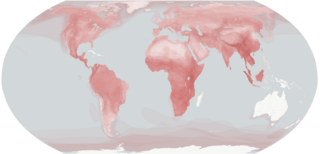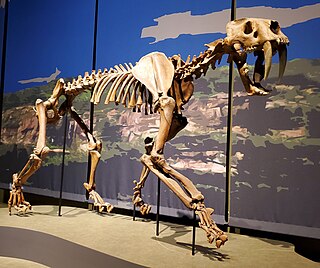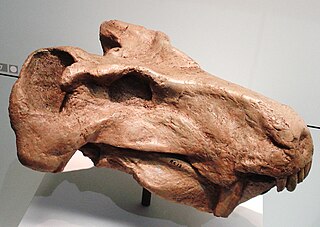Related Research Articles

Carnivora is an order of placental mammals that have specialized in primarily eating flesh, whose members are formally referred to as carnivorans. The order Carnivora is the sixth largest order of mammals, comprising at least 279 species on every major landmass and in a variety of habitats, ranging from the cold polar regions of Earth to the hyper-arid region of the Sahara Desert and the open seas. These mammals have a large array of diverse body plans with a wide diversity of shapes and sizes.

Smilodon is an extinct genus of felids. It is one of the best known saber-toothed predators and prehistoric mammals. Although commonly known as the saber-toothed tiger, it was not closely related to the tiger or other modern cats, belonging to the extinct subfamily Machairodontinae, with an estimated date of divergence from the ancestor of living cats around 20 million years ago. Smilodon was one of the last surviving machairodonts alongside the distantly related Homotherium. Smilodon lived in the Americas during the Pleistocene epoch. The genus was named in 1842 based on fossils from Brazil; the generic name means "scalpel" or "two-edged knife" combined with "tooth". Three species are recognized today: S. gracilis, S. fatalis, and S. populator. The two latter species were probably descended from S. gracilis, which itself probably evolved from Megantereon. The hundreds of specimens obtained from the La Brea Tar Pits in Los Angeles constitute the largest collection of Smilodon fossils.

The dire wolf is an extinct canine. The dire wolf lived in the Americas during the Late Pleistocene and Early Holocene epochs. The species was named in 1858, four years after the first specimen had been found. Two subspecies are recognized: Aenocyon dirus guildayi and Aenocyon dirus dirus. The largest collection of its fossils has been obtained from the Rancho La Brea Tar Pits in Los Angeles.

Canis is a genus of the Caninae which includes multiple extant species, such as wolves, dogs, coyotes, and golden jackals. Species of this genus are distinguished by their moderate to large size, their massive, well-developed skulls and dentition, long legs, and comparatively short ears and tails.

Amphicyonidae is an extinct family of terrestrial carnivorans belonging to the suborder Caniformia. They first appeared in North America in the middle Eocene, spread to Europe by the late Eocene, and further spread to Asia and Africa by the early Miocene. They had largely disappeared worldwide by the late Miocene, with the latest recorded species at the end of the Miocene in Africa. They were among the first carnivorans to evolve large body size. Amphicyonids are colloquially referred to as "bear-dogs".

Cope's rule, named after American paleontologist Edward Drinker Cope, postulates that population lineages tend to increase in body size over evolutionary time. It was never actually stated by Cope, although he favoured the occurrence of linear evolutionary trends. It is sometimes also known as the Cope–Depéret rule, because Charles Depéret explicitly advocated the idea. Theodor Eimer had also done so earlier. The term "Cope's rule" was apparently coined by Bernhard Rensch, based on the fact that Depéret had "lionized Cope" in his book. While the rule has been demonstrated in many instances, it does not hold true at all taxonomic levels, or in all clades. Larger body size is associated with increased fitness for a number of reasons, although there are also some disadvantages both on an individual and on a clade level: clades comprising larger individuals are more prone to extinction, which may act to limit the maximum size of organisms.

Nyctereutes is a genus of canid which includes only two extant species, both known as raccoon dogs: the common raccoon dog and the Japanese raccoon dog. Nyctereutes first entered the fossil record 5.5 million years ago (Mya) in northern China. It was one of the earliest canines to arrive in the Old World. All but two species became extinct before the end of the Pleistocene. A study suggests that the evolution of Nyctereutes was influenced by environmental and climatic changes, such as the expansion and contraction of forests and the fluctuations of temperature and precipitation.

The Society of Vertebrate Paleontology (SVP) is a professional organization that was founded in the United States in 1940 to advance the science of vertebrate paleontology around the world.

Viverravidae is an extinct monophyletic family of mammals from extinct superfamily Viverravoidea within the clade Carnivoramorpha, that lived from the early Palaeocene to the late Eocene in North America, Europe and Asia. They were once thought to be the earliest carnivorans and ancestral to extant ones, but now are placed outside the order Carnivora based on cranial morphology as relatives to extant carnivorans.

Dinogorgon is a genus of gorgonopsid from the Late Permian of South Africa and Tanzania. The generic name Dinogorgon is derived from Greek, meaning "terrible gorgon", while its species name rubidgei is taken from the surname of renowned Karoo paleontologist, Professor Bruce Rubidge, who has contributed to much of the research conducted on therapsids of the Karoo Basin. The type species of the genus is D. rubidgei.

Carnivoramorpha is a clade of placental mammals of clade Pan-Carnivora from mirorder Ferae, that includes the modern order Carnivora and its extinct stem-relatives.

A hypercarnivore is an animal which has a diet that is more than 70% meat, either via active predation or by scavenging. The remaining non-meat diet may consist of non-animal foods such as fungi, fruits or other plant material. Some extant examples of hypercarnivorous animals include crocodilians, owls, shrikes, eagles, vultures, felids, most wild canids, polar bear, odontocetid cetaceans, snakes, spiders, scorpions, mantises, marlins, groupers, piranhas and most sharks. Every species in the family Felidae, including the domesticated cat, is a hypercarnivore in its natural state. Additionally, this term is also used in paleobiology to describe taxa of animals which have an increased slicing component of their dentition relative to the grinding component. In domestic settings, e.g. cats may have a diet designed from only plant and synthetic sources using modern processing methods. Feeding farmed animals such as alligators and crocodiles mostly or fully plant-based feed is sometimes done to save costs or as an environmentally friendly alternative. Hypercarnivores need not be apex predators. For example, salmon are exclusively carnivorous, yet they are prey at all stages of life for a variety of organisms.
The Romer-Simpson Medal is the highest award issued by the Society of Vertebrate Paleontology for "sustained and outstanding scholarly excellence and service to the discipline of vertebrate paleontology". The award is named in honor of Alfred S. Romer and George G. Simpson.

Rubidgea is a genus of gorgonopsid from the upper Permian of South Africa and Tanzania, containing the species Rubidgea atrox. The generic name Rubidgea is sometimes believed to be derived from the surname of renowned Karoo paleontologist, Professor Bruce Rubidge, who has contributed to much of the research conducted on therapsids of the Karoo Basin. However, this generic name was actually erected in honor of Rubidge's paternal grandfather, Sydney Rubidge, who was a renowned fossil hunter. Its species name atrox is derived from Latin, meaning “fierce, savage, terrible”. Rubidgea is part of the gorgonopsian subfamily Rubidgeinae, a derived group of large-bodied gorgonopsians restricted to the Late Permian (Lopingian). The subfamily Rubidgeinae first appeared in the Tropidostoma Assemblage Zone. They reached their highest diversity in the Cistecephalus and Daptocephalus assemblage zones of the Beaufort Group in South Africa.
Xiaoming Wang is a Chinese-born American vertebrate paleontologist and geologist who lives and teaches in the United States.
Richard Hall Tedford was Curator Emeritus in the Department of Vertebrate Paleontology of the American Museum of Natural History in New York City, having been named as curator in 1969.

Homotherini (Machairodontini) is a tribe of saber-toothed cats of the family Felidae. The tribe is commonly known as scimitar-toothed cats. These saber-toothed cats were endemic to North America, Europe, Asia, Africa, and South America from the Miocene to Pleistocene living from c. 23 Ma until c. 12,000 years ago. The evolutionary relationship between the tribes Homotherini and Machairodontini cause paleontologists to classify Homotherini either as a subtribe of Machairodontini, or the same tribe often using either name interchangeably.
Paul David Polly is an American paleontologist and the Robert R. Shrock Professor in the Department of Earth and Atmospheric Sciences at Indiana University as well as the sitting chair of the department.
Anjali Goswami is a Resesarch Leader and Dean of the Graduate Centre at the Natural History Museum. She is an Honorary Professor of Paleobiology at University College London (UCL) in the Department of Genetics, Evolution, and Environment. She was elected President of the Linnean Society of London, in 2022 and is the first person of colour elected to this role since its founding in 1788. She was elected Fellow of the Royal Society in 2024. Goswami's expertise is in vertebrate evolution and development, particularly using high-resolution 3D images of specimens to quantify and reconstruct the evolution of biodiversity and understand how development, ecology and large-scale environmental effects have shaped animal evolution through deep time.
References
- 1 2 3 Van Valkenburgh, Blaire (1984). A Morphological Analysis of Ecological Separation Within Past And Present Predator Guilds (Carnivore, Competition). Baltimore Maryland: PhD Dissertation, Johns Hopkins University. pp. 1–286. ProQuest 303319590.
- 1 2 3 4 5 6 7 Van Valkenburgh, Blaire. "Curriculum Vitae" (PDF). UCLA. Retrieved 22 Jul 2018.
- ↑ "Archived copy". Archived from the original on 2018-10-22. Retrieved 2018-10-21.
{{cite web}}: CS1 maint: archived copy as title (link) - ↑ "Past Award Winners and Grant Recipients".
- ↑ Van Valkenburgh, Blaire. "Public Comments for Virtual School Board Meetings #120" (PDF).
- ↑ "Activist, Aide Lois Van Valkenburgh Dies - The Washington Post". archive.vn. 2020-11-20. Archived from the original on 2020-11-20. Retrieved 2020-11-21.
- ↑ Walker, Alan; Shipman, Pat (2005). The Ape in the Tree: an Intellectual and Natural History of Proconsul. Cambridge, Massachusetts: Belknap Press of Harvard University. pp. 1–291. ISBN 978-0-674-01675-0.
- ↑ "Van Valkenburgh, Blaire". UCLA. Retrieved 22 July 2018.
- ↑ Hoffman, Haley (23 September 2015). "Blaire Van Valkenburgh to deliver lecture as part of Phi Beta Kappa's Visiting Scholars program". Center College, Danville, Kentucky. Archived from the original on 6 August 2020. Retrieved 23 July 2018.
- ↑ Bates-Duke, Karl (28 October 2015). "Math proves ancient cats could hunt mammoths". Futurity. Retrieved 23 July 2018.
- ↑ "Blaire Van Valkenburgh: Staring down the saber-tooths". TrowelBlazers. 9 May 2014. Retrieved 23 Jul 2018.
- ↑ Van Valkenburgh, Blaire (2016). "The impact of large terrestrial carnivores on Pleistocene ecosystems". Proceedings of the National Academy of Sciences. 113 (4): 862–867. Bibcode:2016PNAS..113..862V. doi: 10.1073/pnas.1502554112 . PMC 4743832 . PMID 26504224.
- ↑ Van Valkenburgh, Blaire (2007). "Déjà vu: the evolution of feeding morphologies in the Carnivora". Integrative and Comparative Biology. 47 (1): 147–163. doi: 10.1093/icb/icm016 . PMID 21672827.
- ↑ "Society of Vertebrate Paleontology Past Presidents". Society of Vertebrate Paleontology. Archived from the original on 7 June 2019. Retrieved 22 July 2018.